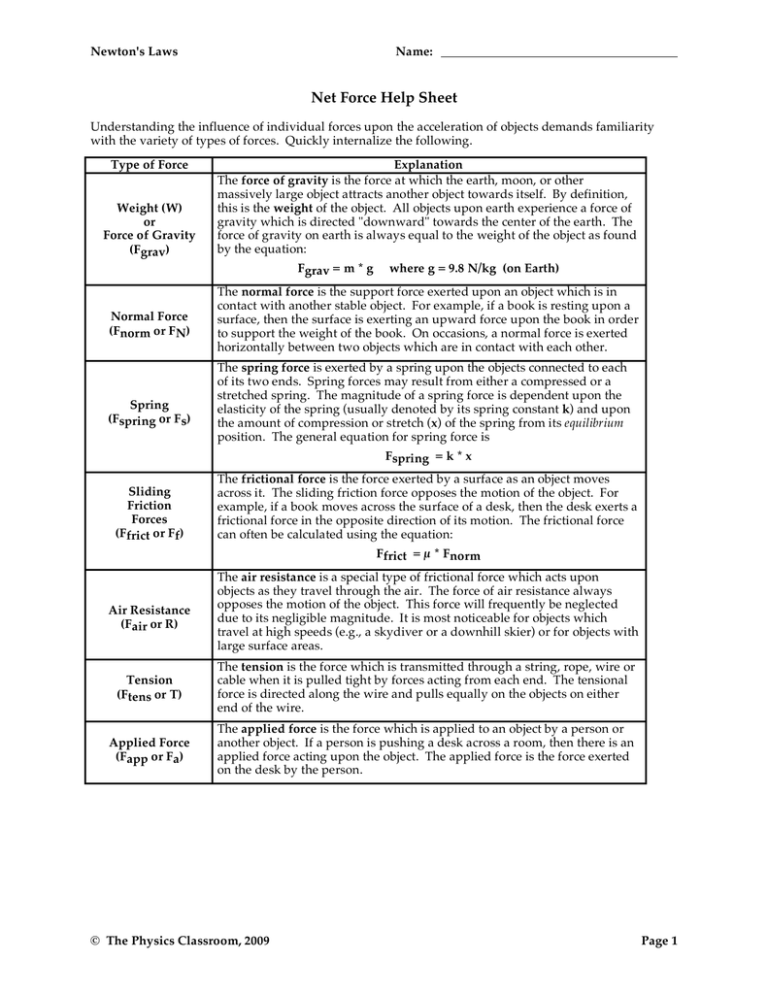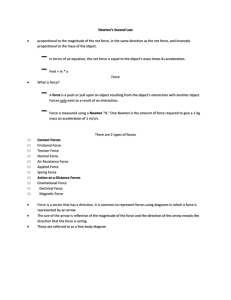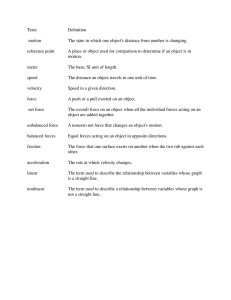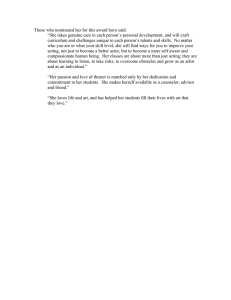Net Force Help Sheet - The Physics Classroom
advertisement

Newton's Laws Name: Net Force Help Sheet Understanding the influence of individual forces upon the acceleration of objects demands familiarity with the variety of types of forces. Quickly internalize the following. Type of Force Weight (W) or Force of Gravity (Fgrav) Explanation The force of gravity is the force at which the earth, moon, or other massively large object attracts another object towards itself. By definition, this is the weight of the object. All objects upon earth experience a force of gravity which is directed "downward" towards the center of the earth. The force of gravity on earth is always equal to the weight of the object as found by the equation: Fgrav = m * g Normal Force (Fnorm or FN) Spring (Fspring or Fs) where g = 9.8 N/kg (on Earth) The normal force is the support force exerted upon an object which is in contact with another stable object. For example, if a book is resting upon a surface, then the surface is exerting an upward force upon the book in order to support the weight of the book. On occasions, a normal force is exerted horizontally between two objects which are in contact with each other. The spring force is exerted by a spring upon the objects connected to each of its two ends. Spring forces may result from either a compressed or a stretched spring. The magnitude of a spring force is dependent upon the elasticity of the spring (usually denoted by its spring constant k) and upon the amount of compression or stretch (x) of the spring from its equilibrium position. The general equation for spring force is Fspring = k * x Sliding Friction Forces (Ffrict or Ff) The frictional force is the force exerted by a surface as an object moves across it. The sliding friction force opposes the motion of the object. For example, if a book moves across the surface of a desk, then the desk exerts a frictional force in the opposite direction of its motion. The frictional force can often be calculated using the equation: Ffrict = µ * Fnorm Air Resistance (Fair or R) The air resistance is a special type of frictional force which acts upon objects as they travel through the air. The force of air resistance always opposes the motion of the object. This force will frequently be neglected due to its negligible magnitude. It is most noticeable for objects which travel at high speeds (e.g., a skydiver or a downhill skier) or for objects with large surface areas. Tension (Ftens or T) The tension is the force which is transmitted through a string, rope, wire or cable when it is pulled tight by forces acting from each end. The tensional force is directed along the wire and pulls equally on the objects on either end of the wire. Applied Force (Fapp or Fa) The applied force is the force which is applied to an object by a person or another object. If a person is pushing a desk across a room, then there is an applied force acting upon the object. The applied force is the force exerted on the desk by the person. © The Physics Classroom, 2009 Page 1 Newton's Laws The Net Force The net force is the vector sum of all the individual forces acting upon an object. In other words, Fnet = F1 + F2 + F3 + ... where F1, F2, and F3 represent the various forces acting upon an object. Like any force, the net force is a vector and has a direction. Being the vector sum of all the forces, there may be some negative signs present in the net force equation to indicate that one force is opposite in direction to another force. According to Newton's second law, the net force is related to mass and acceleration Fnet = ∑F = m * a Other Noteworthy Items: 1. Scales are devices which are equipped with springs that are compressed or stretched when objects are placed upon the scales. These springs allow the scales to measure the magnitude of other forces (i.e., normal forces, tensional forces, gravitational forces, etc.) acting upon the object. 2. Pulleys are objects which change the direction of a force but not its magnitude. Problem-Solving Strategy: To solve problems involving several forces acting upon a single object: 1. Sketch a free-body diagram (FBD). To simplify the diagram, represent the object by a "box". Draw arrows representing all the forces acting on the object. The direction of each arrow should indicate the direction of the force. 2. Label each arrow on the FBD with a symbol to indicate the type of force it is. Use the table above to help you label the forces appropriately. 3. Write down all given information in variable form (e.g., m = 2.0 kg; a = 1.5 m//s, right). Write down the desired end - what the problem asks to be determined or calculated (e.g., find Fapp). 4. The net force is the vector sum of all the individual forces acting on the object. The "summing" of individual forces is simplified if the horizontal and vertical forces are summed separately. Indicate this in the form of equations based upon the FBD. Horizontal Vertical ∑Fx = Fright - Fleft (assumes that rightward is the + direction) ∑Fy = Fup - Fdown (assumes that up is the + direction) 5. Write the net force equations (∑Fx = m * ax and ∑Fy = m * ay). 6. Solve the problem for the desired information by relating the #4 and the #5 equations. Perhaps the most difficult (and most critical) principle of mechanics is the principle of net force and acceleration. You will probably be tempted to approach Fnet problems in a memorization mode. Avoid such an approach; nothing could lead you into a state of frustration more readily. Rather, internalize the meaning of the various forces, learn to recognize their presence by careful analysis of a problem, and base your problem-solving strategies on an understanding of such concepts and upon the application of good logic and reasoning. Approach Fnet problems in logic mode. © The Physics Classroom, 2009 Page 2



